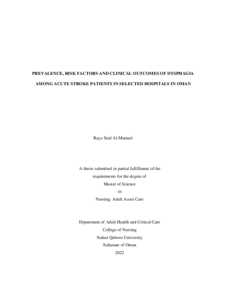Document
Prevalence, risk factors and clinical outcomes of dysphagia among acute stroke patients in selected hospitals in Oman.
Other titles
مدى انتشار عسر البلع ما بعد السكتة الدماغية والعوامل المتسببة والنتائج السريرية لعسر البلع بين مرضى السكتة الدماغية في سلطنه عمان
Publisher
Sultan Qaboos University.
Gregorian
2022
Language
English
English abstract
Background: Dysphagia following a stroke occurs frequently in stroke populations. Up
to 80% of stroke patients suffer from dysphagia. It is associated with increased
morbidity, mortality and healthcare costs due to aspiration, pneumonia, and malnutrition,
which represent a significant burden to stroke survivors, their relatives and the healthcare
system. Early recognition and management of poststroke dysphagia is key to reducing its
complications and enhancing patients' quality of life. Despite the importance of
dysphagia following a stroke and its adverse consequences, no study has investigated
dysphagia after stroke in Oman.
Aim: The study was conducted to estimate the prevalence of poststroke dysphagia and its
severity among acute stroke patients, assess the association between the selected factors
and dysphagia, identify dysphagia predictors and explore its impacts on clinical
outcomes (degree of disability including mortality, presence of nasogastric tube (NGT)
and stroke-associated pneumonia and length of hospitalization).
Method: A cross-sectional descriptive study design was utilized to identify the
prevalence and risk factors for poststroke dysphagia and its clinical outcomes among
acute stroke patients (n=274) admitted to two Omani tertiary hospitals (Sultan Qaboos
University Hospital and Khoula Hospital) over six months. Dysphagia was assessed
using the Gugging swallowing screen (GUSS). The Modified Rankin Scale (mRS) was
used to measure the degree of disability, including mortality at discharge. Descriptive
analysis, correlations and regression analysis were computed.
Results: The prevalence of dysphagia following stroke was 70.1%. Among those who
had dysphagia, 37.5% had severe, 31.25% moderate, and 31.25% mild dysphagia. Aging,
obesity, having a medical comorbidity, hypertension (HTN), stroke location, low
Glasgow Coma Scale (GCS) score, and the use of thrombectomy or thrombolysis therapy
were contributing factors and were found to be correlated with poststroke dysphagia.
This study revealed that old age (OR =.961, 95% CI:.933 -.989, p = 0.007), obesity (OR
=.387, 95% CI:.157 -.952, p =.039), and low GCS score (OR =.027, 95% CI:.009 –.077,
p= <.001) were predictors of dysphagia after stroke. It is also significantly associated
with prolonged NGT use during admission and at discharge and length of hospital stay
and an increased degree of disability, including mortality and incidence of stroke associated pneumonia.
Conclusion: Poststroke dysphagia is more common among acute stroke patients, and it is
associated with negative outcomes. There are various risk factors correlated with
dysphagia following a stroke. Therefore, dysphagia predictors should be considered
when designing dysphagia prevention strategies to reduce its adverse consequences.
Recognition of such predictors may help with the early detection and treatment of
dysphagic patients and the implementation of preventive approaches.
Member of
Resource URL
Arabic abstract
الخلفية: يحدث عسر البلع بعد السكتة الدماغية بشكل متكرر في مرضى السكتة الدماغية. ويرتبط ذلك بزيادة معدل الوفيات وتكاليف الرعاية الصحية بسبب الالتهاب الرئوي وسوء التغذية، والتي تمثل عبئا كبيرا على الناجين من السكتة الدماغية وأقاربهم وعلى نظام الرعاية الصحية أيضا. يعد التعرف المبكر على عسر البلع بعد السكتة الدماغية وإدارته مفتاحا للحد من مضاعفاته وتقليل التكاليف المتعلقة بعسر البلع من أجل تحسين نوعية حياة المرضى. الهدف: تهدف هذه الدراسة إلى تقدير مدى انتشار وشده عسر البلع ما بعد السكتة الدماغية بين مرضى السكتة الدماغية في سلطنة عمان، وتقييم العالقة بين العوامل المختارة وعسر البلع بعد السكتة الدماغية، وتحديد العوامل المتنبئة به واستكشاف تأثيره على درجة الاعاقة ومعدالت الوفيات والالتهاب الرئوي وطول مدة الاقامة في المستشفى. المنهجية: تم استخدام تصميم الرصد الاستباقي لتحديد مدى انتشار وعوامل عسر البلع بعد السكتة الدماغية بين مرضى السكتة الدماغية )n = 274)، الذين تم تنويمهم في مستشفيين من الدرجة الثالثة في عمان خالل ستة أشهر. تم تقدير عسر البلع باستخدام مقياس البلع )GUSS). واستخدم مقياس الرنكين (mRS (لقياس درجة العجز عند الخروج من المستشفى. كذألك شمل التحليل الوصفي المتوسط والانحراف المعياري والتكرار والنسبة المئوية. كما أجريت تحليلات الارتباط والانحدار. النتائج: كانت نسبه انتشار عسر البلع ما بعد السكتة الدماغية %70.1 وأكثر من %37 كانت لديهم درجه قوية لصعوبة البلع و%31.25 لكل منهم درجه متوسطة وضعيفة. ووجد أن العديد من العوامل ترتبط بشكل كبير بعسر البلع وهي العمر والسمنة ووجود أمراض أخرى مثل الضغط وموقع السكتة الدماغية ومستوى الوعي والادراك وعالج انحالل الجلطات الدموية. وجدت هذه الدراسة ايضا أن العمر = p -.989, :.933CI 95% .961, =OR( (0.007 والسمنة (.039= p -.952, :.157CI 95% .387, =OR (وانخفاض مستوى الادراك .027,= OR( (.001> =p .077, –:.009CI 95% هي مؤشرات لعسر البلع بعد السكتة الدماغية وأنها أطالت بشكل كبير استخدام الانبوب الانفي المعدي أثناء الدخول وعند الخروج وطول مدة الاقامة في المستشفى، وزيادة معدالت الاعاقة والالتهاب الرئوي والوفيات. الاستنتاج: عسر البلع بعد السكتة الدماغية هو أكثر شيوعا بين مرضى السكتة الدماغية، ويرتبط معه النتائج السلبية. هناك العديد من العوامل المرتبطة بعسر البلع بعد السكتة الدماغية. لذلك ينبغي مراعاتها عند تصميم استراتيجيات للحد من عواقب عسر البلع السلبية. قد يساعد التعرف على هذه المتنبئات في الكشف المبكر عن مرضى عسر البلع وعالجهم مبكًرا وتنفيذ النهج الوقائية.
Category
Theses and Dissertations

